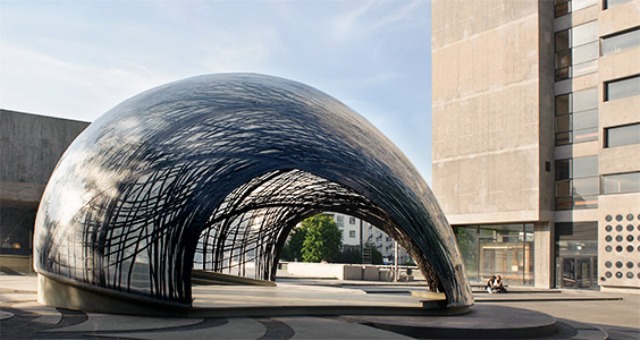Aug 13 2015
Simultaneously lightweight and stable like a spider’s thread: that is the hallmark of the University of Stuttgart’s 2014/2015 research pavilion. The employees of the Institute for Computational Design (ICD) and the Institute of Building Structures and Structural Design (ITKE) actually got the inspiration for the design from nature. The manner in which the water spider builds its nests under water served as the example.
 ©ICD/ITKE Universität Stuttgart
©ICD/ITKE Universität Stuttgart
The spider builds a bell-shaped nest with its threads in the water and then fills it with air. This air bubble ensures that the spider can survive under water. It even lays its eggs inside the bubble. Inspired by this unique way of building, the research pavilion first consisted of a soft ETFE foil supported by air pressure. Carbon fibers were then gradually glued on from the inside with help from a KUKA robot from the KR QUANTEC ultra family.
The result: an ultra-light fiber-composite shell. This gives the pavilion not only its shape but also its unique architectural quality. Since the carbon fibers are only applied where they are required to support the design and the pneumatic formwork is also used as a functionally integrated building envelope, the construction process does not produce waste and conserves resources.
In order to place the carbon fibers on the inside of the pliant foil, a prototype robotic manufacturing process was developed. This was a particular challenge for control of the robot since the stiffness of the pneumatic formwork changes during the fiber application process and produces fluctuating deformations. To allow these parameters to be adapted throughout the manufacturing process, the current position and application pressure are detected using an integrated sensor system and integrated into the robot controller in real time. This type of cyber-physical system enables constant feedback between the real manufacturing conditions and the digital generation of the robot control code. This represents not only an important development within the framework of this project, but also points the way more generally to new possibilities for robotic construction processes.
During manufacture, nine preimpregnated carbon fiber rovings with a total length of 45 km were applied along a 5 km robot path at an average velocity of 0.6 m/min. The pavilion comprises a surface area of approximately 40 m² and an enclosed volume of roughly 130 m³ – while reaching a width of 7.5 m and a height of 4.1 m. The total weight is no more than around 280 kg, corresponding to an area density of 7 kg/m². The pavilion evolved at the intersection between the research at both institutes and instruction under the interdisciplinary and international ITECH Master’s program. It is the result of a year and a half of development by scientists as well as students in architecture, engineering and the natural sciences.
View the video about the project here: https://vimeo.com/icd/rp14-15